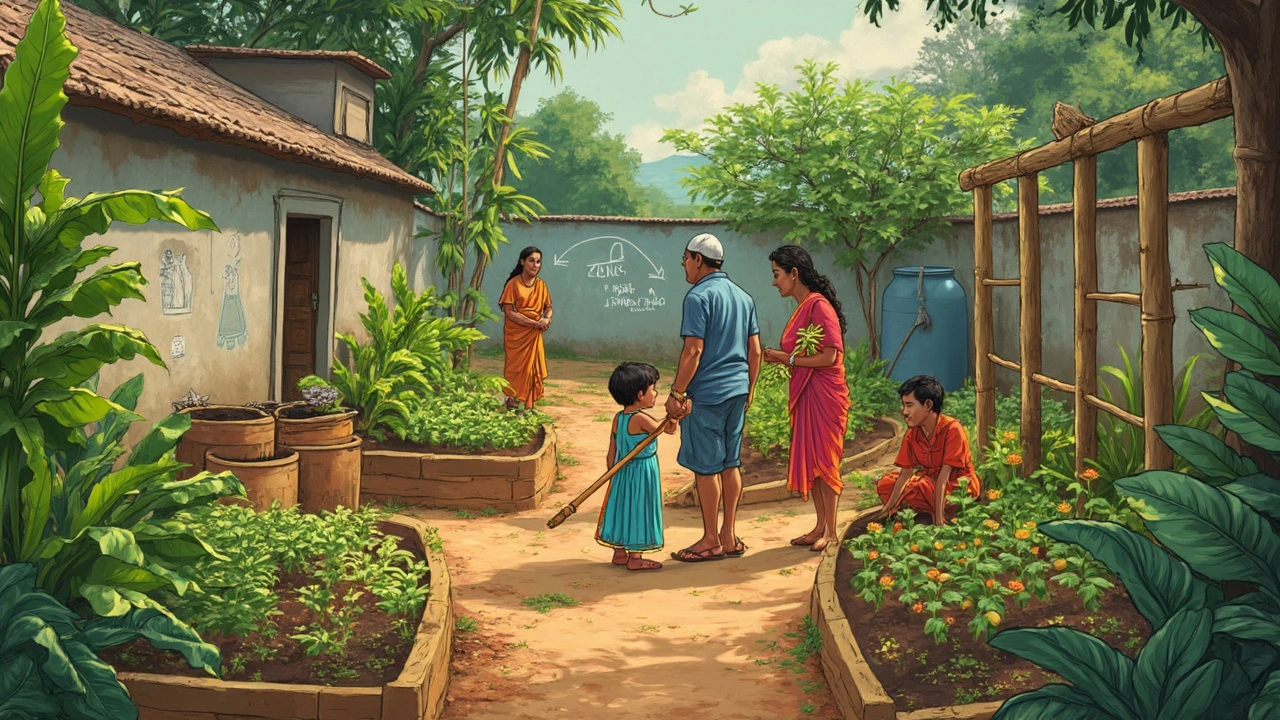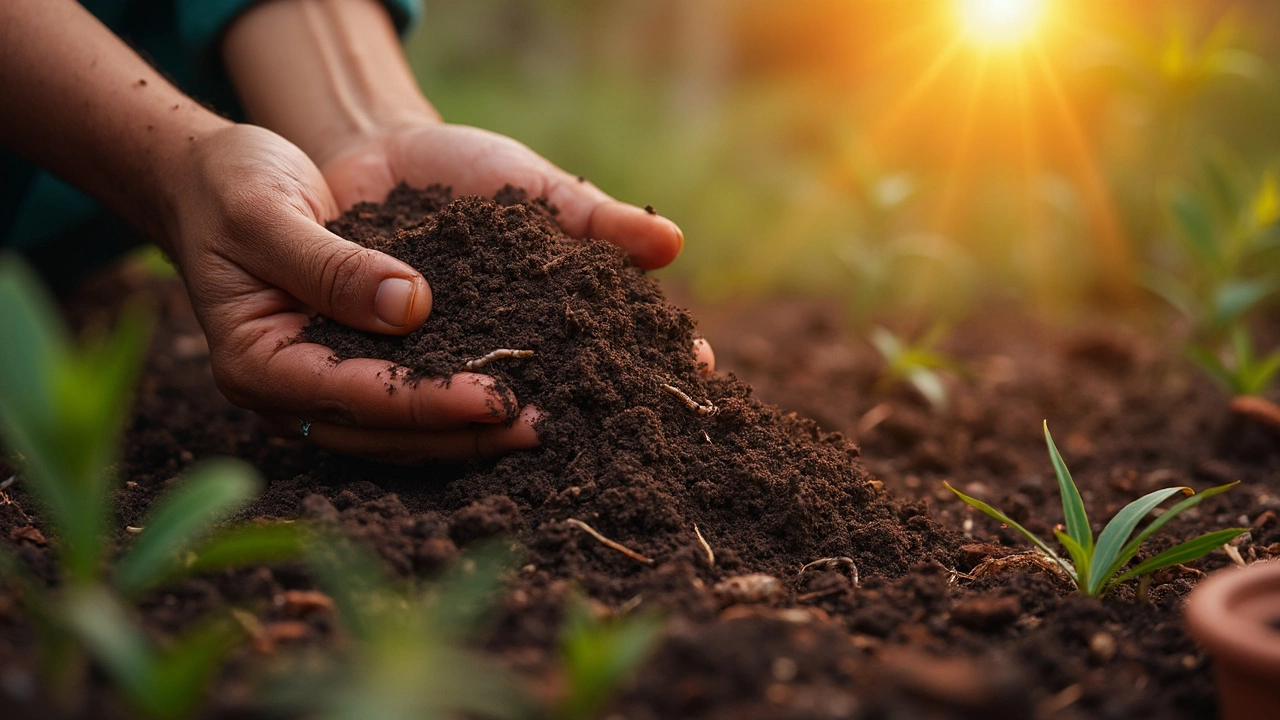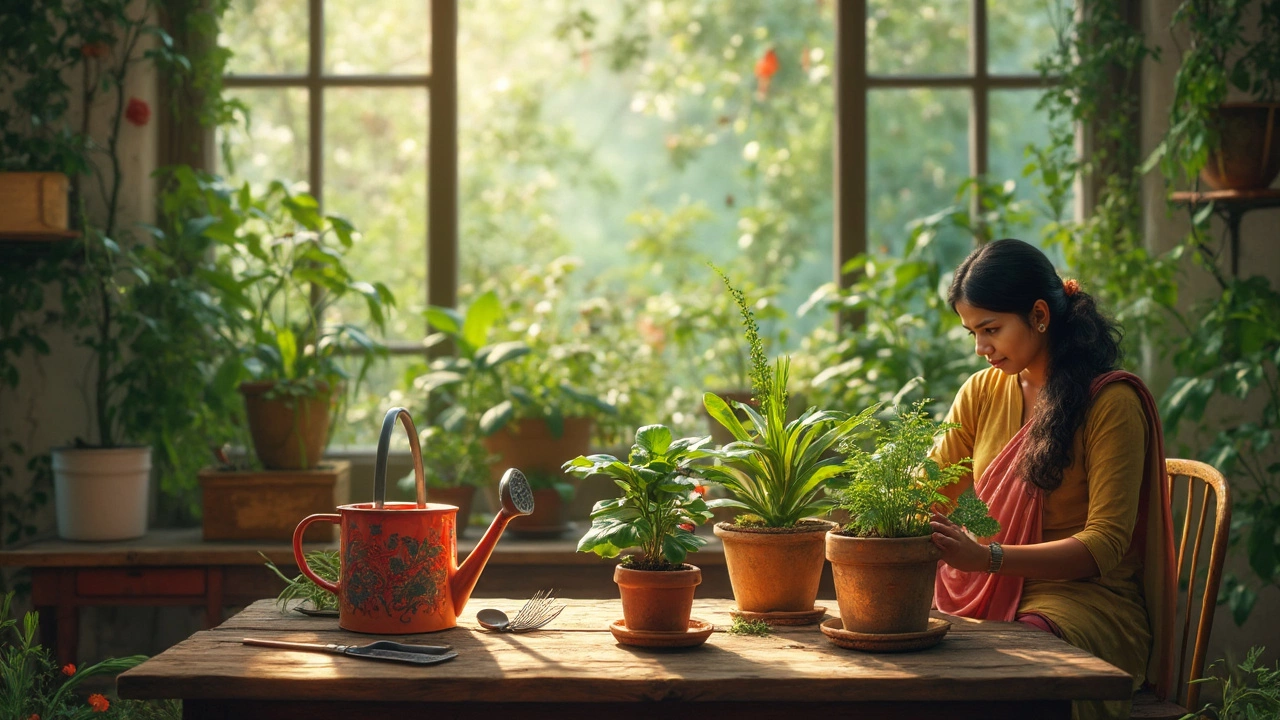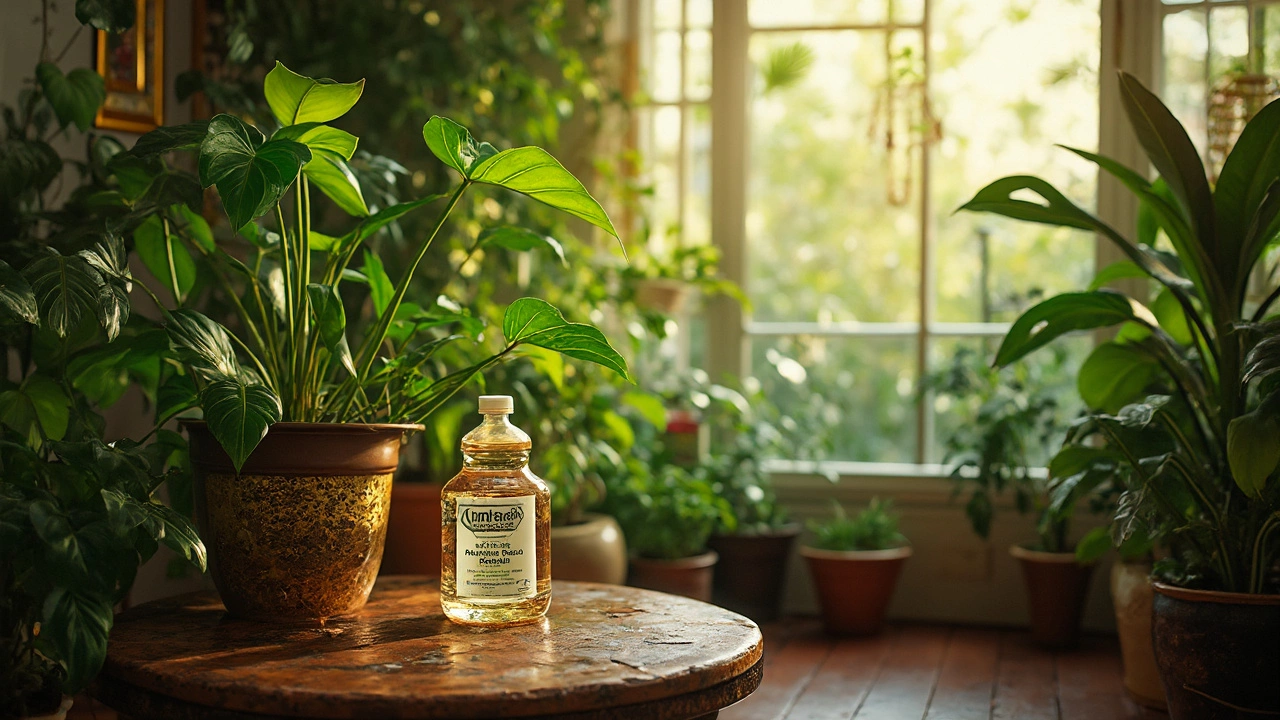Permaculture vs Regenerative Gardening: What Sets Them Apart?

Ever feel overwhelmed by all the eco-friendly gardening buzzwords out there? Permaculture and regenerative gardening get tossed around like they're the same thing, but dig a little deeper and the differences start popping up all over the place. If you've ever wondered which one actually fits your space, lifestyle, or values, you're not alone, and you don't need a degree to figure it out.
Here's the thing: Both approaches go way beyond simply growing tomatoes and roses. Permaculture is all about designing everything to work together, almost like planning a mini-ecosystem in your yard. Think long-term, joined-up thinking—putting plants, water, animals, and you into a clever system that needs less work and waste over time.
Regenerative gardening, though? That's laser-focused on healing. It's about bringing your soil back to life, pumping up biodiversity, and making your plot better every season, even if you're starting with sad, compacted dirt. It's hands-on, and anyone with a patch of land can start seeing changes fast.
Not sure which path to pick? Stick around. You'll see exactly what makes these two ideas tick, how people actually use them, and a few tricks to combine the best of both in your backyard—no matter how small or wild it is.
- Permaculture: The Whole System Mindset
- Regenerative Gardening: Repairing and Reviving the Soil
- Key Differences in Approach and Practice
- Real-life Applications and Results
- How to Choose for Your Garden
- Pro Tips to Blend Both in Your Backyard
Permaculture: The Whole System Mindset
If you ask gardeners who are into permaculture what it's all about, they'll probably talk your ear off about design. Think of permaculture as the blueprint for your whole space—plants, animals, water, soil, people—all working together in a way that mimics nature. It's not just about what you plant, it's about how every part connects.
Permaculture borrows a lot from how forests or wild meadows take care of themselves. Instead of fighting weeds and pests all the time, the goal is to set things up so that everything balances out naturally. This doesn't mean you let things grow wild; it means you design your space so that each part supports the others. For example, chickens might eat bugs, while their manure helps fertilize trees. Your rain barrel can catch water to use during dry spells, keeping the garden thriving without a huge water bill.
The three core ethics of permaculture are super straightforward:
- Care for the Earth (healthy soil, clean water, more trees)
- Care for People (sharing yields and creating space everyone can enjoy)
- Fair Share (using what you need and passing on extra resources)
Here's where permaculture stands out from regular gardening: it uses principles like "start small and slow," "use and value diversity," "catch and store energy," and "produce no waste." For example, you might put your herbs close to the kitchen door (for easy picking), stack tall sun-loving plants behind lower shade-lovers, or let clover spread between veggie rows to fix nitrogen in the soil.
Want a peek at how much time this can save? Some permaculture gardens need 30% less watering and half the fertilizer compared to typical gardens. It's all about planning smart and letting nature do the heavy lifting.
Here's a quick cheat sheet of classic permaculture features you can spot or try:
- Swales (shallow ditches) to slow and sink rain runoff
- Food forests with layers: trees, shrubs, ground cover, vines, roots
- Compost bins built right into the garden beds
- Zones: intensive crops next to your house, wild zones farther out
Think of permaculture as your game plan for a sustainable gardening setup that's less about short-term fixes and more about a system that keeps getting better on its own.
Regenerative Gardening: Repairing and Reviving the Soil
Grass may look green, but for real health, it's all about what's happening underground. Regenerative gardening dials in on building up soil life and getting nature working in your favor. If you want fat earthworms, crumbly soil, and plants that mostly take care of themselves, this method hits the mark. It's not just organic gardening—it's supercharged, always improving each year you stick with it.
Healthy soil is loaded with microbes, fungi, bugs, and organic matter. Regenerative gardeners know that tilling and chemicals wipe out these helpers. So instead, this approach uses techniques that boost soil health naturally. Here's what it looks like in practice:
- No-till or low-till: Ditch the traditional digging. Minimizing disturbance keeps soil structure and protects the living network underground.
- Cover crops: Planting rye, clover, or buckwheat between harvests covers bare dirt, fixes nitrogen, and adds organic material when turned under or chopped down.
- Compost and mulch: Adding compost feeds the soil microbiome. Mulch keeps moisture in and temperature steady, plus it breaks down over time.
- Crop rotation and diversity: Swapping out what grows in a bed each season and mixing up plant types stops pests from getting comfy and boosts resilience.
- Keeping roots in the ground year-round: Permanent beds and overlapping crops mean something is always feeding soil life.
Why does all this matter? Soil that's alive stores way more water and nutrients, shrugs off droughts better, and even grabs atmospheric carbon. A 2023 study out of Australia found that regenerative gardening plots had up to 20% higher soil organic matter than conventional beds—translating straight to better yields and hardier plants.
| Method | Soil Organic Matter (%) | Water Holding Capacity |
|---|---|---|
| Regenerative | 5.5 | High |
| Conventional | 3.8 | Moderate |
It's not about perfection—it's about improvement each season. Even small tricks like top-dressing beds with compost or tossing kitchen scraps in a worm bin can make big changes over time. The best part? This is gardening that actually gets easier (and cheaper) as the soil heals itself. You don't need fancy gear or expensive inputs, just patience and consistency with these simple habits.
Key Differences in Approach and Practice
Here’s where things really split between permaculture and regenerative gardening. Sure, both sound eco-friendly, but what you actually do in the garden can look completely different, depending on which path you take.
Permaculture is all about big-picture design. Imagine you’re setting up your garden so every part helps another part. Chickens eat pests, trees block wind, water always goes where it’s needed most. The focus is on sustainable gardening that mimics natural systems. You’ll spend a ton of brainpower up front, mapping things out, observing, and stacking functions. For example, a permaculture plan might include:
- Plant guilds—groups of plants that support each other (like fruit trees with companion herbs and ground covers).
- Zones of use—placing the stuff you use most (herbs, veggies) closest to your door, and things that need less attention farther away.
- Rainwater harvesting—setting up swales or barrels to catch runoff for later use.
- Using animals as part of the system—chickens for pest control and soil aeration, maybe even a bee hive for pollination.
On the other side, regenerative gardening puts its muscle into fixing and rebuilding the land—especially the living soil. It’s way more hands-on. You’re actually out there digging in compost, spreading mulch, and trying to bring life back into tired ground. The idea is: Focus on soil health, and the rest follows. In practice, this means:
- Lots of compost—seriously, heaps of it. Anything to feed those soil microbes.
- Cover cropping and green manures—planting stuff just to chop it down and feed the soil.
- Zero tillage—disturbing soil as little as possible to keep structure and life intact.
- No synthetic chemicals—herbicides and pesticides are out.
- Heavy mulching—to hold moisture and keep weeds down.
To make it clear, here’s a quick side-by-side:
| Permaculture | Regenerative Gardening |
|---|---|
| System design; planning before planting | Physical soil repair, ongoing work |
| Whole ecosystem focus—plants, animals, structures, people | Focus on soil biology and plant health |
| Emphasizes permanent systems | Emphasizes ongoing renewal and soil improvement |
| Uses zoning and patterns for efficiency | Uses soil-building practices for resilience |
Think of permaculture as building a Lego city where every block works with another, and regenerative gardening as fixing a patch of dirt so good things can grow again and again. Neither one is better—they just come at sustainability from different angles.

Real-life Applications and Results
It's easy to talk about permaculture and regenerative gardening in theory, but what actually happens when people put these ideas into practice?
Take the example of the Dervaes family in Pasadena, California. They turned a standard city lot (just 1/10th of an acre) into an urban permaculture paradise. They grow over 3,000 pounds of produce a year—enough veggies, fruits, and even eggs to feed a family of four, plus extra to sell locally. They use chickens for pest control and composting, solar panels for energy, and a rainwater catchment system. It’s all intertwined—the way permaculture is supposed to be.
Regenerative gardening can lead to visible improvements fast, especially in places with poor or compacted soil. At Singing Frogs Farm in Sebastopol, California, the owners quit tilling their soil, planted heaps of cover crops, added compost, and built ‘living mulch’ into every bed. In just three years, soil organic matter shot up from under 3% to over 7%. With healthier soil, their yields increased and they cut back on irrigation by about 80%. The farm actually absorbs more carbon than it emits, which is rare for any farming setup.
Want to see results at home? Start by:
- Adding compost or worm castings every season. Healthy soil pays you back with bigger, better crops.
- Planting mixes of veggies, herbs, and flowers together (that’s a classic permaculture move—called companion planting).
- Covering bare spots with mulch or living groundcovers for moisture and weed control.
- Using chickens or ducks for pest control, if your yard and local rules allow it.
- Swapping out chemical fertilizers for homemade compost teas or leaf mulch, building fertility naturally.
Here’s a quick look at how these strategies stack up in measurable gains:
| Method | Years to Visible Results | Soil Organic Matter (%) | Water Usage Reduction |
|---|---|---|---|
| Permaculture (Dervaes Family) | 2-5 | 6+ | ~50% |
| Regenerative Gardening (Singing Frogs) | 1-3 | 3 to 7+ | ~80% |
So, both sustainable gardening methods turn out real results. You’ll eat better food, use less water, and help the planet. Start with whatever fits your space and time, and the payoffs will add up sooner than you might think.
How to Choose for Your Garden
Deciding between permaculture and regenerative gardening comes down to your goals, how much time you have, and what kind of space you’re working with. There’s no rule saying you must pick one or the other, but knowing the differences can save you a lot of headaches and wasted effort.
If you love planning, spreadsheets, and the idea of an ecosystem where everything supports everything else, permaculture could be your style. For example, in suburban backyards, permaculture often means lots of upfront design—like figuring out where water runs, how the sun moves, and what you can plant together so you don’t have to weed or water as much. It's more about working with whole systems, not just growing a few veggies.
On the flip side, regenerative gardening is perfect if you want to take action right away and see results season by season. If your soil is sad or you have a yard that’s been neglected for years, regenerative methods like composting, mulching, cover cropping, and rotating crops can work like magic. This approach is hands-on and practical—great for people who want quick wins and healthier soil for growing food.
Here’s a practical way to figure out which fits you best:
- Ask yourself: Am I someone who wants to design a whole system (permaculture), or do I want to fix my soil and boost my harvests ASAP (regenerative)?
- Consider your timeline. Permaculture can take more time upfront, but less labor later. Regenerative gardening has faster first results, but you’ll be out there mulching and planting season after season.
- Look at your space: If you have a small urban yard or even just raised beds, regenerative techniques are usually easiest to start. If you have a bigger suburban lot or want to create a community garden, permaculture’s big-picture planning might pay off more down the road.
According to a 2022 survey in the US, 65% of home gardeners doing regenerative practices saw improved soil health and plant yields in just one year. That’s a solid boost if you’re hungry for instant progress.
| Factor | Permaculture | Regenerative Gardening |
|---|---|---|
| Planning | High upfront | Low to medium |
| Time to See Results | Slower start, long-term payoff | Fast improvements, ongoing work |
| Best For | Larger spaces, whole-system thinkers | Small gardens, hands-on doers |
Try not to stress about choosing the “right” method. Lots of folks blend both. You might start with regenerative steps to bring your soil back, then lay on some permaculture design later. Both routes help you build a healthy, resilient plot while keeping things eco-friendly.
Pro Tips to Blend Both in Your Backyard
Merging permaculture ideas with regenerative gardening isn’t just possible—it actually creates a garden that’s smart and tough as nails. You can get the big-picture benefits of permaculture’s planning, plus the fast payoffs of regenerative methods that revive your soil.
Here’s how you can pull off this power combo in your own space:
- Plan zones and sectors smartly. Lay out your yard so the stuff you use most (herbs, salad greens, worm composters) are closest to your kitchen or main hangout spot. This nod to permaculture’s "zone system" saves steps every single day.
- Pile on organic matter. Regenerative gardens run on mulch, compost, and dead plant bits—nature’s free fertilizer. Aim to cover all bare soil with at least a 5cm (2-inch) layer. No more naked dirt, no more wasted water.
- Grow a mixed crew of plants. Permaculture loves diversity, and regenerative systems need it to outsmart pests and diseases. Try planting fruit trees with clover, onions, and calendula underneath. Bonus: pollinators go nuts for this kind of planting.
- Chop and drop. This hands-on trick is straight from both playbooks. When you prune (even weeds!), drop the trimmings back onto the soil. They feed worms and micro-creatures underground, boosting soil health naturally.
- Skip digging when you can. Use no-dig beds, build up layers with cardboard, compost, and straw. This is huge in regenerative gardening—protects your soil’s precious structure, and saves your back.
- Capture every drop you can. Both methods swear by smart water use. Set up rain barrels, swales (little ditches), or just dig slight dips where rainwater tends to run off. When you slow water down, your soil holds it longer.
Here’s a quick-check table of which ideas come from where. Some crossover, but you get the idea:
| Technique | Permaculture | Regenerative Gardening |
|---|---|---|
| Zone Planning | ✔️ | ➖ |
| Deep Mulching | ✔️ | ✔️ |
| No-Dig Beds | ➖ | ✔️ |
| Diverse Plant Guilds | ✔️ | ✔️ |
| Water Catchment | ✔️ | ✔️ |
Don’t worry about doing it all at once. Pick one change, try it out for a season, and see how your space responds. Over time you’ll get a yard that’s self-repairing, less thirsty, and a heck of a lot less work. That’s the magic of combining permaculture and regenerative gardening.





